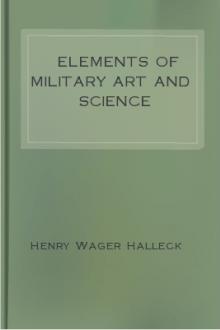Elements of Military Art and Science by Henry Wager Halleck (books you have to read txt) 📕

- Author: Henry Wager Halleck
- Performer: -
Book online «Elements of Military Art and Science by Henry Wager Halleck (books you have to read txt) 📕». Author Henry Wager Halleck
Mines.—By mining, as a military term, we understand the operations resorted to for the demolition, with powder, of a military structure of any description. The term mine is applied both to the excavation charged with powder for the purpose of producing an explosion, and to the communications which lead to this excavation.
The place in which the charge of powder is lodged is called the chamber, the communication by which this place is reached the gallery, and the excavation made by the explosion is termed the crater.
The form of the crater caused by an explosion in ordinary soils is assumed to be a truncated cone, the diameter, c d, (Fig. 53,) of the lower circle being one-half the diameter, a b, of the upper circle. This form has never been ascertained to be exactly correct, but the theoretical results deduced from a mathematical discussion of this figure have been fully verified in practice. The radius, p b, of the upper circle is termed the crater radius; the line o p, drawn from the centre of the charge perpendicular to the surface where the explosion takes place, is termed the line of least resistance; the line o b, drawn from the centre of the powder to any point in the circumference of the upper circle, is termed the radius of explosion.
When the crater radius is equal to the line of least resistance, the mine is termed common; when this radius is greater than the line of least resistance, the mine is termed overcharged; and when the radius is less, undercharged. A mine of small dimensions, formed by sinking a shaft in the ground, is termed a fougasse. The term camouflet is applied to a mine used to suffocate the enemy's miner, without producing an explosion. Small mines made in rock or masonry, merely for the purpose of excavation, without any considerable external explosion, are called blasts.
From experiments made on common mines, whose line of least resistance did not exceed fifteen feet, it has been ascertained that the tenacity of the earth is completely destroyed around the crater to a distance equal to the crater radius, and that empty galleries would be broken in at once and a half that distance. It has also been proved by experiment, that the crater radius in overcharged mines may be increased to six times the line of least resistance, but not much beyond this; that within this limit the diameter of the crater increases nearly in the ratio of the square roots of the charge; and that empty galleries may be destroyed by overcharged mines at the distance of four times the line of least resistance.
By means of the deductions of physico-mathematical theory, and the results of experiments, rules have been determined by which the miner can calculate, with much accuracy, the charge necessary to produce a required result in any given soil.
In the earlier stages of the history of this art, mines were only used to open breaches and demolish masses of masonry; but in later times they have been employed as important elements in the attack and defence of places.
An isolated wall, only two or three feet thick, may readily be demolished by exploding one or two casks of powder placed in contact with its base. If the wall be five or six feet thick, the charges should be placed under the foundation. For walls of still greater thickness it will be best to open a gallery to the centre of the wall, a foot or two above its base, and place the powder in chambers thus excavated. Revetment walls may be overturned by placing the charges at the back of the wall, about one-third or one-quarter of the way up from the base. If placed too near the base, a breach will be made in the wall without overturning it.
To demolish a bridge of masonry the powder should be lodged in chambers excavated in the centre of the piers. When there is not time for excavating these chambers in the piers, a trench may be cut over the key of the arch, in which the powder is placed and exploded; or, the casks of powder may be suspended immediately under the arch, with the same results. Where a saving of powder is of consequence, small chambers may be excavated in the haunches of the arch, and the mine carefully tamped before firing it.
Bridges of wood may be destroyed by suspending casks of powder under the principal timbers, or attaching them to the supports.
Palisading, gates, doors, &c., may be destroyed in the same way, by suspending casks or bags of powder against their sides; or still more effectually, by burying the charges just beneath their base.
To demolish a tower, magazine, or house, of masonry, place charges of powder under the piers and principal walls of the building. In wooden structures the powder should be placed under, or attached to the principal supports. Where time is wanting to effect these arrangements, a building may be blown down by placing a large mass of powder in the interior. The powder may be economized, in this case, by putting it in a strong case, which should be connected with the walls of the building on all sides by wooden props.
Special treatises on military mining contain full instructions for regulating the size and position of the charge for the various cases that may be met with in the practical operations of field-engineering.
As applied to the attack and defence of a fortified place, mines are divided into two general classes—offensive and defensive mines. The former are employed by the besiegers to overthrow the scarps and counterscarps of the place, to demolish barriers, palisades, walls, and other temporary means of defence, and to destroy the mines of the besieged. The latter are employed by the opposite party to blow up the besiegers' works of attack, and to defend the passage of ditches against an assault. Small mines called fougasses may be employed for the last named object. The shell-fougasse is composed of a wooden box filled with one or more tiers of shells, and buried just below the surface of the earth. Sometimes a quantity of powder is placed under the shells, so as to project them into the air previous to their explosion. The stone fougasse is formed by making a funnel-shaped excavation, some five or six feet deep, and placing at the bottom a charge of powder enclosed in a box, and covered with a strong wooden shield; several cubic yards of pebbles, broken stone, or brickbats, are placed against the shield, and earth well rammed round, to prevent the explosion from taking place in the wrong direction. These mines are fired by means of powder hose, or by wires connected with a galvanic battery.
The defensive mines employed to blow up the besiegers' works, are generally common mines with the lines of least resistance seldom greater than fifteen feet. All the main galleries and principal branches of mines for a permanent fortification are constructed at the same time with the other portions of the work, leaving only the secondary branches, chambers, &c., to be made during the siege. For the general arrangement of these galleries, and the precautions necessary for their protection from the operations of the besiegers, reference must be made to treatises specially devoted to the discussion of this subject.
Mines can seldom be employed with advantage in works of slight relief, and liable to an assault. But if judiciously arranged in the plan of their construction, and well managed during the operations of the siege, they contribute very materially to the length of the defence.
Attack and defence.—This subject admits of two natural divisions: 1st, of intrenchments, and 2d, of permanent works.
I. Intrenchments maybe attacked either by surprise, or by open force. In either case the operations should be based on exact information of the strength of the works and the number and character of the garrison—information that can be obtained from spies, deserters, and prisoners, and confirmed by examinations or reconnaissances made by officers of engineers. By these means a pretty accurate knowledge may be obtained of the natural features of the ground exterior to the works; their weak and strong points; and their interior arrangements for defence.
In an attack by surprise, the troops should consist of a storming party and a reserve of picked men. The attacking column is preceded by a company of sappers armed with axes, shovels, picks, crowbars, &c.; bags of powder are also used for blowing down gates, palisades, &c. All the operations must be carried on with the utmost dispatch. The time most favorable for a surprise is an hour or two before day, as at this moment the sentinels are generally less vigilant, and the garrison in a profound sleep; moreover, the subsequent operations, after the first surprise, will be facilitated by the approach of day. Under certain circumstances, it may be advisable to make false attacks at the same time with the true one, in order to distract the attention of the garrison from the true point of danger. But false attacks have, in general, the objection of dividing the forces of the assailants as well as of the assailed. In all attacks by surprise, secrecy is the soul of the enterprise.
In an open assault, if artillery be employed, the troops should be drawn up in a sheltered position, until the fire of the works is silenced, and breaches effected in the parapet. But if the bayonet alone be resorted to, the troops are immediately brought forward at the beginning of the assault. The attack is begun by a storming party of picked men: they are preceded, as before, by a body of sappers, provided with necessary means for removing obstacles, and followed by a second detachment of engineers, who will widen the passages, and render them more accessible to the main body of troops who now advance to the assistance of the storming party. If the assailants should be arrested at the counterscarp by obstacles which must be removed before any farther progress can be made, the infantry troops of the detachment display and open a fire upon the assailed, in order to divert their fire from the sappers. A few pieces of light artillery, on the flanks of the column, may sometimes be employed for this purpose with great advantage.
The storming party should always be provided with scaling-ladders, planks, fascines, &c., for crossing the ditch, and mounting the scarp. If the counterscarp be revetted with masonry, the troops must either descend by ladders, or fill up the ditch with fascines, bales of straw, bundles of wool, &c.: if not revetted, a passage for the troops into the ditch will soon be formed by the shovels of the sappers. When the ditch is gained, shelter is sought in a dead angle till the means are prepared for mounting the scarp, and storming the work. If the scarp be of earth only, the sappers will soon prepare a passage for the escalade; but if revetted with masonry, the walls must be breached with hollow shot, or scaled by means of ladders.
In the defence, the strictest vigilance should be at all times exerted to guard against a surprise: sentinels are posted on all the most commanding points of the work; all the avenues of approach are most thoroughly guarded; and patroles are constantly scouring the ground in all directions. At night all these precautions are redoubled. Light and fire-balls are thrown out in front of the work to light up the ground, and discover the movements and approach of the enemy. Each man should have his particular post assigned to him, and be thoroughly instructed in the duties he will have to perform. All auxiliary arrangements, such as palisades, abattis, &c., should be defended with the utmost obstinacy; the longer the enemy is held in check by these obstacles, the longer will he be exposed





Comments (0)